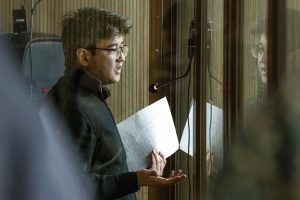On May 13, former Minister of Economy of Kazakhstan Kuandyk Bishimbayev received 24 years in prison for murder (specifically, “murder committed with extreme cruelty”) and torture. Bishimbayev killed his wife, Saltanat Nukenova, in the bathroom of a restaurant in Astana in November 2023, but a history of beatings and abuse long preceded that tragic night.
Bishimbayev’s trial, which began on March 27, was the first to be live-streamed in Kazakhstan. With millions of people watching, the spectacle of his trial drew much-needed attention to Kazakhstan’s endemic problem of domestic violence.
Mia Tarp Nurmagambetova has already written for The Diplomat about how Bishimbayev’s trial put domestic violence on the agenda for Kazakhstani lawmakers. Activists have been pushing for stricter punishment for gender-based violence for years, and they got a hard-earned win in April: President Kassym-Jomart Tokayev signed a new law criminalizing domestic violence.
Stronger protections against spousal abuse were not the only significant reform that coincided with Bishimbayev’s trial, though.
On March 12, one day after Judge Aizhan Kulbaeva agreed to Bishimbayev’s request for a jury trial, Kazakhstan’s lower chamber of parliament, the Majilis, approved the first reading of a bill to revamp the country’s approach to juries.
Juries have been a fixture of Kazakhstan’s legal system since 2007, when the country adopted hybrid juries. Unlike the “classic” model of jury trials, where the jury deliberates without a judge present and votes independently on whether to convict, under the hybrid model, jurors and the judge make the decision together.
Variations of the hybrid model are used in democratic countries across Europe, but the power dynamic inherent in Kazakhstani jury deliberations has been a point of contention for watchdog organizations. Lawyer Aigerim Kusainkyzy posed a rhetorical question to Vlast in an explainer on jury trials, “What are the chances that a fair and honest decision will be made behind the closed door of the deliberation room?”
The U.S. State Department’s 2022 report on human rights in Kazakhstan noted that “prosecutors dominated trials, and defense attorneys played a minor role.” But if anything, the opposite was true for Bishimbayev’s trial. Local media coverage of the trial noted the defense team’s chutzpah in the early days of the trial. Vlast noted that “there was a feeling that the process was controlled not by judge Aizhan Kulbaeva, but by Bishimbayev’s lawyers.” On April 11 Bishimbayev’s legal team tried to file a complaint against the judge – which she summarily rejected.
Kulbaeva was criticized for barring the media from the courtroom on April 10. The decision was interpreted as an effort to silence the free press, but Kulbaeva made the call in an effort to maintain the anonymity of the jurors.
There’s no how-to guide for running a trial that’s gone viral, and the judge’s management of the courtroom was evidence of the government’s struggle to balance transparency with control. In the end, Kulbaeva rolled back the restrictions on press in the courtroom on April 22, even after threats to her personal safety.
That this decisionmaking happened under the watch of millions demonstrates the potential for the Bishimbayev trial to expand legal literacy in Kazakhstan. As jury trials become more commonplace in Kazakhstan, officials hope that the public will grow to have more confidence in the justice system. It takes a lot of energy and resources to educate a country on legal reforms, though, and the intensity of media coverage of this case catalyzed a sort of extra-governmental campaign to inform average people on how juries and courts operate.
Media outlets and social media channels published explainers on the history of jury trials in Kazakhstan. Articles and YouTube interviews describe all the steps of the process and explain the significance of different features of institutional design, like the hybrid model or the voting rules for a lifetime sentence. An interview with lawyer Dzhokhar Utebekov by a Forbes Kazakhstan journalist posted on April 16 has racked up 908,000 views in less than a month. A 17-minute video posted by Giperborei on May 13 that outlines the results of the trial had 541,000 views in less than 24 hours.
This type of legal literacy is crucial in a country like Kazakhstan, where talk of reform, democratization, and transparency dominate politicians’ rhetoric. And that rhetoric has translated into results. The World Justice Project ranked Kazakhstan 65th globally in 2023. Since 2016, the organization found that measures of rule of law had fallen in 78 percent of countries studied, but Kazakhstan is one of the few where rule of law has actually improved.
One of the key fixtures of rule of law is that every person, regardless of wealth or privilege, should face accountability before the law.
In Bishimbayev’s case, there was initially some concern that his privileged position would get him off easy. Given that Bishimbayev – whose father was a deputy of the Majilis and who was made a minister in the government at age 36 – was pardoned and released on parole in 2019 while serving time for accepting bribes, this was not an unsubstantiated fear.
But on the flip side, in a country where people in power have historically been able to skirt legal consequences for their actions, there’s also a temptation to use a trial like this to teach the privileged class a lesson. In a spirited speech in the last days of the trial, lawyer Igor Vranchev declared, “By unanimously recognizing Bishimbayev guilty and not giving him a chance to be released at all, you will free our entire Kazakhstan, our entire people from such elitist parasites.”
While there was a small protest in Almaty decrying that Bishimbayev should have received a life sentence, 24 years is hardly getting off easy. Of course, there’s time for Bishimbayev’s legal team to file an appeal, and it’s possible he will get out on parole before the 24 years he’s been sentenced to are up.
For now, though, it appears that judge Kulbaeva and the jury have struck a balance between competing incentives.

































